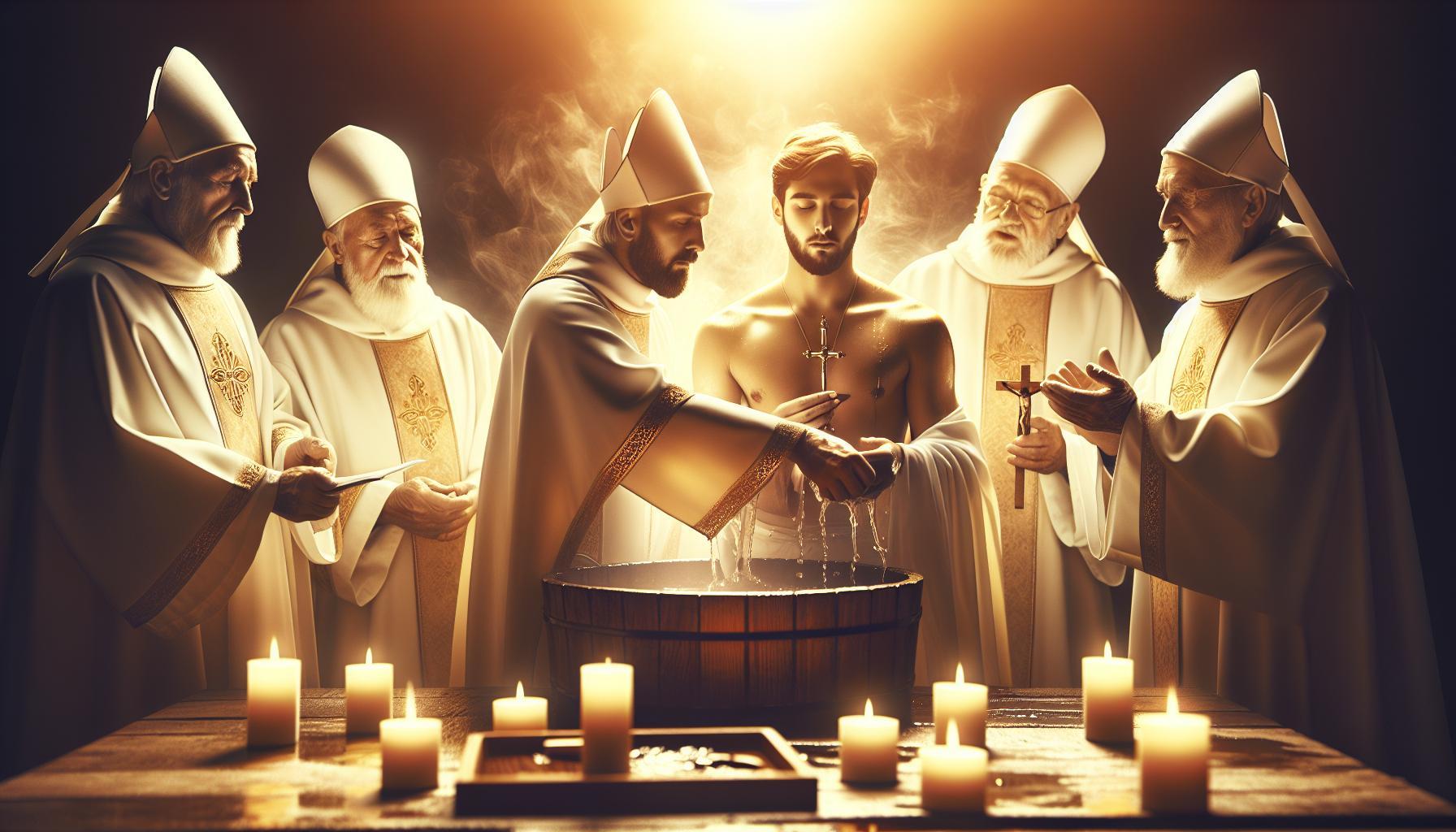Wondering how much to give a priest for a baptism? Navigating the customs of gratuity in religious ceremonies can be confusing. Understanding the appropriate range for priest donations not only shows appreciation for their role but also aligns with community expectations. Dive into these guidelines to make an informed decision.
Understanding the Role of a Priest in Baptism: A Spiritual Perspective
Baptism is a sacred rite that marks the entrance of an individual—commonly an infant—into the Christian faith. This transformative ceremony signifies not only a spiritual rebirth but also the community’s commitment to nurturing the faith of the baptized. Central to this significant event is the priest, who plays an indispensable role as a spiritual guide, administer, and facilitator of the baptismal sacrament.
Spiritual Guidance and Leadership
The priest’s primary responsibility during baptism extends beyond merely performing ritualistic actions; it encompasses offering spiritual guidance to families and individuals. Here’s how priests contribute to the spiritual dimensions of baptism:
- Preparation: Priests often engage in pre-baptism classes with the parents, addressing the significance of the sacrament and the responsibilities that come with it. They help parents understand their role in fostering a Christian upbringing for their child.
- Personal Connection: Establishing rapport is essential. A priest may take time to connect personally with the family, ensuring that the baptism feels meaningful and tailored to their spiritual needs.
- Community Integration: The priest emphasizes the community’s role in supporting the spiritual development of the baptized. This is crucial in creating a nurturing environment for the child’s faith journey.
Administration of the Sacrament
When baptizing, the priest acts as a conduit of grace, facilitating the act of baptism itself. This involves a few key elements:
- Rituals and Prayers: The priest performs specific rituals such as anointing with oil, pouring water, and offering prayers that invoke blessings upon the baptized. These acts hold deep theological significance, symbolizing purification and initiation into the faith.
- Engagement with the Congregation: During the baptism, the priest invites the congregation to participate, fostering a communal atmosphere. This collective affirmation reinforces the idea of shared faith and responsibility.
- Follow-Up: After the baptism, the priest often remains a support system for the family, offering resources and guidance as they navigate the spiritual upbringing of their child.
Considerations on Gratuity and Compensation
Understanding how much to give a priest for baptism is an important consideration for many families. Gratuity guidelines are not just about monetary compensation; they reflect the appreciation for the priest’s dedication and spiritual labor. Here are some practical steps families can consider:
| Consideration | Suggested Amount |
|---|---|
| Standard Donation for Baptism | $100 – $300 |
| Additional Gifts (e.g., flowers, cards) | As desired |
| Special Requests or Additional Services | Negotiable |
Being aware of these guidelines can help families show gratitude without feeling uncertain about what’s appropriate. The essence of the priest’s role extends beyond the ceremony itself; they foster a deeper understanding of faith and community, making the contribution feel like a meaningful exchange of respect and appreciation.
Typical Gratuity Ranges: What Others Are Giving
When considering a gift for a priest during a baptism ceremony, many parents find themselves wondering how much is appropriate. While devotion and spiritual guidance are priceless, expressing gratitude with a monetary offering is a custom that varies widely depending on individual circumstances, regional practices, and the priest’s affiliation. Understanding the typical gratuity ranges can help you make an informed decision that feels comfortable and respectful.
Common Gratuity Amounts
The amount you choose to give can depend on several factors, including the complexity of the service, your connections to the church, and the priest’s usual compensation for such rites. To provide some clarity, here’s a general overview of what others typically offer:
| Region | Typical Range | Example Situations |
|---|---|---|
| Urban Areas | $100 – $300 | Full-service baptism, larger congregations |
| Suburban Areas | $75 – $200 | Private baptism, mid-sized churches |
| Rural Areas | $50 – $150 | Family-oriented or community-focused congregations |
Generally, $100 is a common baseline for urban ceremonies, while smaller communities may see gifts start around $50. In some regions, informal community norms strongly influence these amounts, with many parents contributing towards church upkeep as a sign of communal appreciation.
Additional Considerations
While these ranges offer a starting point, it is important to consider personal circumstances. Factors such as your financial situation, the priest’s relationship with your family, and the overall church culture can impact this decision. Here are some practical tips:
- Reflect on the context: Consider how much significance the baptism holds for your family and what the priest’s role has been in your faith journey.
- Check local norms: Speak with family or friends who have recently had their children baptized to gauge expectations in your area.
- Opt for personal touches: Some families include a heartfelt note or a small personal gesture alongside any monetary gift, which can enhance the sincerity of your appreciation.
This balance of gratitude and personal connection will not only honor the ritual but also foster a meaningful bond with your priest as you embark on this new chapter of spiritual commitment. Understanding how much to give a priest for baptism through these gratuity guidelines ensures your gesture is both meaningful and appropriate.
Considering Your Church’s Traditions: A Denominational Approach
When welcoming a new life into the faith through baptism, the traditions and expectations around the ceremony can significantly vary between denominations. Understanding these customs is crucial, not only for honoring the significance of the event but also for ensuring that any gratuities offered are in line with practices within your church community. Each denomination has unique practices that shape the relationship between clergy and congregants, including expectations surrounding monetary gifts and expressions of gratitude.
Denominational Variations
Different Christian denominations often have distinct approaches regarding the role of the priest or minister during baptism and the associated gratuity. Here are a few examples of how practices might differ:
- Roman Catholic: Baptism is typically a sacrament celebrated in a formal setting. The expectation might be a set amount, usually ranging from $50 to $200, depending on the parish. It’s customary to make this offering directly to the church, often given in an envelope.
- Eastern Orthodox: In the Orthodox tradition, the baptismal ceremony includes a more communal aspect, which often results in a lower expectation for personal gratuities, sometimes around $50.
- Protestant: Many Protestant denominations see baptism as a joyful community event. Here, gratuities are not typically expected. Instead, congregants might contribute to a church fund or charitable cause as a way of participating in the community celebration.
- Anglican: Similar to Roman Catholic practices, Anglicans may suggest a gratuity. Influenced by local customs, this might range from $50 to $150 depending on the church’s guidelines.
Practical Steps for Offering Gratuities
Understanding your church’s traditions will shape not only the amount you might consider when pondering how much to give a priest for baptism but also the manner in which you present it. Begin by speaking with church staff or fellow congregants to grasp the cultural nuances:
- Ask the Church Office: Most churches have a general guideline for gratuities; you can inquire discreetly.
- Consult with Recently Baptized Families: Other families may provide insight into their own experiences.
- Consider Timing: Present your gratuity as soon as possible after the baptism, ideally during a personal thank-you or within a week following the ceremony.
By integrating these steps, you will be able to honor the traditions of your denomination while also providing a heartfelt thank you to the priest, ensuring your generosity aligns with community expectations and practices.
Factors Influencing Your Gift: Financial and Personal Considerations
When considering a gift for a priest during a baptism, both financial and personal factors play crucial roles in determining the appropriate gratuity. Financially, it’s essential to assess your budget and what represents a meaningful donation. While traditional guidelines suggest an amount ranging from $20 to $150, the exact figure can vary based on your financial situation and the nature of your relationship with the priest. For instance, if you are a close family member or a lifelong member of the parish, you might feel inclined to give more than a casual acquaintance would.
Understanding Personal Considerations
Personal considerations also significantly influence the amount you decide to give. Reflecting on your relationship with the priest can help you determine a thoughtful gratitude expression. Considerations such as the priest’s role in your family’s spiritual journey, the frequency of your interactions, and the overall impact they have had on your life can guide your decision. A larger gift can symbolize a deeper appreciation and acknowledgment of their service and support.
Community and Custom
Cultural and community standards also come into play. In some areas, it is customary to give a certain amount that aligns with the community’s expectations. Engaging with other parents who have recently baptized their children can provide insight into local norms and help you frame your gift appropriately within your community.
| Relationship to Priest | Suggested Amount |
|---|---|
| Close Family Member | $100 – $150 |
| Regular Parishioner | $50 – $100 |
| Occasional Visitor | $20 – $50 |
Ultimately, the key is to balance what you feel comfortable giving while ensuring the gift reflects your appreciation for the priest’s presence during an important moment in your family’s life. By taking into account both financial capabilities and personal connections, you can arrive at a well-considered amount that aligns with the spirit of the occasion and fulfills the guidelines surrounding how much to give a priest for baptism.
Crafting a Thoughtful Expression of Gratitude: Beyond Monetary Gifts
When it comes to expressing gratitude, the feelings often go beyond monetary compensation. In the context of baptisms, acknowledging the priest’s service through thoughtful gestures can leave a lasting impression, both for the individual and the community. While it can be tempting to focus solely on how much to give a priest for baptism, considering alternative ways to show appreciation can foster a deeper connection and appreciation for the sacred occasion.
Meaningful Ways to Show Gratitude
Gifts that reflect personal gratitude or appreciation for the priest’s role in your child’s spiritual journey can transcend the value of money. Here are some thoughtful alternatives to consider:
- Personalized Thank-You Notes: A handwritten note expressing your heartfelt thanks can touch the heart. Mention specific moments from the baptism or how the ceremony impacted your family.
- Homemade Treats: If you have culinary skills, consider baking or preparing a dish to share. This can also foster a sense of community as the priest shares in your family’s celebration.
- Book Donations: Contributing a religious book or resource to the church library in the priest’s name can be a meaningful way to honor their service and benefit the congregation.
- Acts of Service: Volunteer to help out in church activities or projects. Showing appreciation through service can often resonate more than money.
Crafting a Personalized Gift
If you prefer to give something tangible, consider crafting a gift that reflects the priest’s interests or the community’s needs. Personalized gifts that connect to the priest’s ministry can be greatly appreciated. Here are a few ideas:
| Gift Type | Description | Considerations |
|---|---|---|
| Religious Art | A decorative piece that can enhance their office or personal space. | Consider their aesthetic and the message the art conveys. |
| Personalized Vestments | Items like stoles that are customized for the church season. | Consult with the church on color or style preferences. |
| Gift Certificates | Cultural or local restaurants where they can relax and enjoy. | Choose a place that aligns with the priest’s tastes or lifestyle. |
Through gestures of goodwill and gratitude that show you value the priest’s contribution, you create a more meaningful dialogue about faith and community. In a world often guided by transactional exchanges, nurturing relationships through thoughtfulness proves that the true essence of gratitude extends far beyond mere financial obligations.
Discussing the Importance of Respectful Etiquette in Religious Services
Understanding the nuances of etiquette in religious services is fundamental for fostering a respectful and inclusive atmosphere. Attending a baptism, for instance, involves more than just being present; it encompasses a variety of social customs that reflect traditional values and mutual respect among participants. When considering how much to give a priest for baptism, knowing the proper etiquette can not only clarify intentions but also enhance the spiritual experience for everyone involved.
Why Respectful Etiquette Matters
Respectful etiquette serves as a bridge between different beliefs, allowing individuals to honor their traditions and values while acknowledging those of others. In religious settings, etiquette often dictates how attendees should behave, interact, and express gratitude, especially towards clergy. For instance, observing the practice of giving a donation or gratuity to the priest can symbolize appreciation for their role in the ceremony and respect for the religious institution.
- Strengthens Community Bonds: Proper etiquette fosters a sense of community, making everyone feel included and respected during the baptism.
- Fosters Spiritual Connection: Following customary practices enhances the spiritual significance of the event, allowing participants to connect more deeply with their faith.
- Encourages Positive Relationships: Demonstrating respect towards clergy and fellow attendees promotes goodwill and positive relationships, which can have lasting benefits beyond the ceremony.
Practical Guidelines for Gratuity
When pondering the question of how much to give a priest for baptism, understanding the guidelines around gratuity can help clarify expectations. It’s important to remember that these contributions can vary based on location, church policies, and personal circumstances. Here are some practical steps to consider:
| Region | Suggested Gratuity Amount |
|---|---|
| Urban Areas | $100-$300 |
| Suburban Areas | $50-$150 |
| Rural Areas | $25-$100 |
These figures provide a general guideline, but it’s crucial to consider the individual circumstances surrounding the baptism. The intention behind the gesture holds significant value; thus, a heartfelt note of thanks, whether in person or written, can complement any monetary gift, reinforcing the respectful nature of the etiquette surrounding these sacred events. Always remember that the act of giving should come from a place of appreciation, highlighting the importance of respectful interactions within the realm of religious services.
Alternatives to Cash Gifts: Meaningful Ways to Honor Your Priest
Recognizing the dedication and service of your priest during significant life events, such as a baptism, goes beyond the exchange of cash gifts. Many congregants seek to show their appreciation for their spiritual leaders in ways that resonate more deeply with their values and the community spirit. Here are some thoughtful alternatives that can convey your gratitude meaningfully without resorting to monetary gifts.
Personalized Gifts
One of the most heartfelt ways to honor your priest is through personalized gifts that reflect their interests or contributions to the community. Consider the following options:
- Custom-made religious artwork: Commission a local artist to create a piece that relates to the priest’s favorite biblical passages or themes.
- Personalized books: Consider getting a leather-bound Bible or a religious book with an inscription that acknowledges their guidance and support.
- Handwritten letters: Write a heartfelt letter expressing how their teachings have impacted your life and that of your family. Presenting this in a beautiful frame can make it even more special.
Service and Volunteer Efforts
Another meaningful way to honor your priest is through acts of service that align with their mission or the church’s needs. Engaging in community service projects fosters a sense of shared purpose and can be a potent expression of gratitude.
- Organize a community meal: Coordinate with fellow parishioners to prepare and share a meal in honor of your priest, showcasing the community’s love and appreciation.
- Fundraising for church projects: Instead of giving cash directly, perhaps initiate a fundraiser for a cause that the priest is particularly passionate about, such as youth programs or mission trips.
- Participate in church events: Take on roles in church events or volunteering opportunities that lighten the priest’s load, showing solidarity and commitment to the community’s mission.
Creating Lasting Memories
Gifts that create lasting memories not only honor your priest but also enrich the lives of others in the community.
- Memory book: Compile a book of shared experiences and testimonials from congregation members. This can serve as a cherished space for the priest to reflect on the relationships they’ve nurtured.
- Group outings: Plan a group outing or retreat for parishioners with the priest. This could involve a day of fellowship, prayer, and recreation that reinforces community bonds.
- Religious retreats or workshops: Offer to cover the fees for a retreat that your priest has expressed interest in attending. This not only supports their spiritual growth but also shows appreciation for their hard work.
By exploring these thoughtful alternatives, you can express your gratitude in meaningful ways that align with both your values and those of your priest. Whether through personalized gifts, service activities, or memorable experiences, these gestures can leave a lasting impression and strengthen the connection between the priest and your community.
Navigating Conversations About Gratuity with Your Community
One of the most delicate aspects of planning a baptism is figuring out how to interact with your priest regarding gratuity. While this topic might seem uncomfortable, understanding appropriate giving practices can make navigating conversations about gratuity much smoother. Many families often ponder, “How much to give a priest for baptism?” and the answer can vary widely based on cultural, regional, and personal circumstances. However, knowing the norms within your community can provide clarity and help pave the way for a positive experience.
To help facilitate these discussions, consider the following points:
- Research Community Norms: Different regions have their customs regarding gratuity for religious services. Speak with other families, friends, or church members who have recently gone through the baptism process to gauge how much they gave. This inquiry can provide a helpful benchmark and reduce anxiety around the topic.
- Reflect on Your Relationship: If you have an established relationship with your priest, this can influence your decision on how much to give. A parishioner who attends services regularly may feel more comfortable offering a higher amount compared to someone new to the church.
- Consider the Church’s Guidelines: Some churches may have set expectations for gratuity as part of their protocol. Check your church’s website or reach out to the parish office to gather these recommendations.
- Choose a Gratuity Method: Whether it’s cash, a check, or a donation made in the priest’s name to a charity, think carefully about how you want to show your appreciation. Presenting the gift in a thoughtful manner can enhance your message of gratitude.
Before engaging in conversation, it might be helpful to understand the context of your priest’s role during the baptism service. Their responsibilities go beyond the ceremony itself and often include preparation meetings, personalized prayers, and heartfelt counsel. Acknowledging these contributions can guide you to determine an amount that reflects the time and effort they’ve invested in your child’s spiritual journey.
Ultimately, finding a comfortable path to discuss gratuity hinges on open communication. Expressing your appreciation for the priest’s involvement in your family’s special day can foster a positive relationship within the community. If you’re uncertain about how to start the conversation, try phrasing it with sincerity, such as “We truly appreciate the spiritual guidance you’ve provided us, and we would like to recognize that with a gratuity.” This openness not only demonstrates your gratitude but also respects the traditions associated with such significant milestones.
Frequently Asked Questions
How Much to Give a Priest for Baptism?
The typical gratuity for a priest performing a baptism ranges from $100 to $300. This amount can vary based on location, church policy, and the priest’s level of involvement in the ceremony.
It’s essential to consider that this gratuity is often seen as a thank you for the priest’s time and effort in preparing for the sacred event. Some families opt for a higher amount if the priest plays a significant role or if they are part of a particular church community. To learn more about typical baptism practices, check out our article on baptism ceremonies.
What is the purpose of giving a gratuity to a priest for baptism?
Giving a gratuity helps to honor the priest’s commitment and service. It acknowledges the time they dedicate to prepare for the baptism and the spiritual guidance they provide.
In many religious traditions, providing a gratuity or donation is a customary way to express gratitude. This gesture supports the church and the priest’s ministry, ensuring that they can continue their work in the community. It’s also a chance to reflect on the spiritual significance of the baptism in your family’s faith.
Can I give less than the suggested amount for a baptism?
Yes, you can give less than the suggested gratuity. What’s most important is that your offering reflects your appreciation and is within your means.
Many families may find themselves in different financial situations, and it’s perfectly acceptable to contribute an amount that feels comfortable. Remember, the intent behind the gift matters more than the exact figure. If you’re unsure, you can always discuss your contribution with the priest or church office to understand what is acceptable in your community.
Why does the amount for baptism gratuity vary?
The amount can vary due to factors such as location, the priest’s experience, and the church’s rituals. Cultural expectations and local practices also play significant roles.
In urban areas, for example, gratuities may tend to be higher because of the increased cost of living and church operations. Conversely, small towns may have lower customary amounts. Additionally, if the baptism involves special elements like preparation classes or rehearsals, this may influence your decision on the gratuity amount.
How do I present the gratuity to the priest during baptism?
You can present the gratuity discreetly in an envelope before or after the ceremony. This ensures a respectful and private gesture.
Many families choose to give the amount during a meeting with the priest before the baptism or immediately following the ceremony. A simple card expressing your gratitude can accompany the envelope, enhancing the personal touch of your gesture.
Is there a standard practice across different denominations for baptism gratuity?
No, there is no standard practice; it varies by denomination and community norms. Each faith tradition has unique customs regarding services and offerings.
It’s essential to connect with your specific church community to understand their expectations. Some denominations may suggest a specific amount, while others leave it to the discretion of the family. Understanding these nuances can guide you in navigating how much to give a priest for baptism and other ceremonies.
To Wrap It Up
As we conclude our exploration of gratuity guidelines for priests during baptisms, it’s clear that this sacred rite carries not only spiritual significance but also communal responsibility. Remember, the recommended financial contributions can vary widely, shaped by local customs and individual circumstances. Whether you choose to give a set amount, offer a personal gesture, or engage in a deeper conversation with your priest about appropriate stewardship, your intention is what truly matters.
We encourage you to further reflect on your own traditions and consider the role that gratitude plays in your faith journey. Engaging meaningfully with your community can enhance both your and others’ baptism experiences, fostering deeper connections within the body of faith. We invite you to share your thoughts or reach out with any questions as you navigate these spiritual milestones. May your journey of understanding and generosity blossom as you continue to explore the many facets of baptism and its importance in your life and community.





